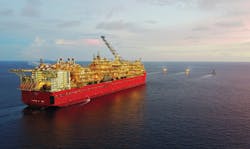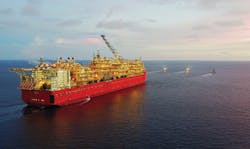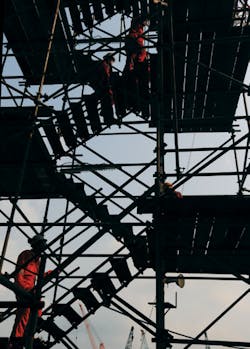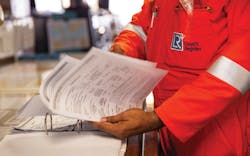Non-prescriptive class guidance the way forward for offshore LNG vessels
Support needed for process plant development, integration
Richard Nott
Mark Tipping
Lloyd’s Register
The Prelude FLNG vessel under tow to the field location in the Browse basin. (Courtesy Shell)
The emergence of floating liquefied natural gas (FLNG) facilities such as Shell’s Prelude and Petronas’ Satu, and Chevron’s Gorgon project offshore Western Australia have greatly increased the availability of LNG in the Asia/Pacific region. As more large-scale LNG projects come on stream the nature of gas as a primary fuel is also changing, both for the developed world and developing economies. Expansion of the gas market is also set to drive down technology costs associated with LNG schemes, thereby opening up gas as a fuel to an even wider market.
With this greater availability, the trading nature of gas too has begun to change. While gas prices have historically tended to be more localized and more dependent on fixed long-term sales contracts than oil, there has been a move of late to a more active spot market, often at considerable discounts to long-term contract pricing. This has been facilitated by increased transportability of LNG due to the growth of the LNG carrier fleet and receiving facilities.
The current lower gas price environment is likely to continue, leading to:
• A push for cheaper, simpler, field development solutions on the upstream (FLNG) side.
• Increased demand for supply-side FSRU (floating storage and regasification unit) solutions. These are on the upside of a lower gas price and provide a practical solution to the growing energy – particularly electricity – demands of developing nations, or anywhere where extended electricity grid networks are impractical.
• Renewed interest in gas compression projects.
There are inevitable knock-on effects on the types and designs of assets favored for production or supply of gas from LNG, with attendant pressures on class societies to deliver rules and guidance for the new offshore vessel designs.
FLNG advantages
A land-based LNG plant fuelled from a very large floating platform would require high-volume gas reserves to justify the high field development capex. FLNG vessels are smaller, simpler assets which can be mobilized more quickly to smaller fields, allowing swift monetization of projects on a smaller scale. Among the options for FLNG vessels are:
• A simpler liquefaction process allowing a smaller footprint, but at reduced efficiency.
• More complex, miniaturized liquefaction plant offering smaller footprint but better efficiency.
• Numerous (more traditional) gas floating production storage and offloading (FPSO) units providing gas conditioning linked with a centralized liquefaction facility – allowing individual units to be smaller and less complex, and potentially reducing the need for more extensive subsea infrastructure.
• FLNG providing solely liquefaction facilities for gas produced and conditioned elsewhere and accessed via land or subsea pipeline. This can bring advantages over land-based solutions for remote areas, and in regions with difficult political or social circumstances.
• Near-shore export FLNG, ranging from simple LNG storage and offloading to full blown FLNG solutions.
All of these options are under review or are being actively developed in response to local needs and circumstances.
Gas compression FPSOs
Due to the continuing need to drive down cost, the industry is seeking innovative solutions to monetize large and small remote offshore gas accumulations. Proposals are under consideration for:
• Very large offshore floating gas compression projects, the upside being the ability to eliminate the need for onboard storage with the complexity and associated cost. There is also sufficient experience and confidence in compressed natural gas (CNG) for combined storage and pipeline solutions.
• Long, deep subsea compressed gas pipelines (the downside and opportunity of not providing onboard storage).
Lloyd’s Register surveyors walking up scaffolding. (Photo courtesy Lloyd’s Register)
FSRU versatility
FSRU designs come in a variety of shapes and sizes. This versatility is the main advantage of FSRUs, particularly over shore-based solutions. However, there are challenges for class societies in terms of producing, revising, and adapting their rules and guidance to meet the differing technical demands, namely:
• Gas ship with re-gasification facilities (which may work as a trading LNG carrier for periods of its life), conversion or newbuild.
• Storage barge with re-gasification facilities.
• Near-shore, at-shore, or at-sea locations.
• Mooring systems, hull and mooring design for tidal conditions (potentially including grounding).
FSRUs incur much lower operating costs than a trading LNG carrier, and the potential these units offer for long-term contracts can make conversion an attractive option for LNG carrier operators.
So where does class fit in this changing environment and how can it support innovative projects while not compromising on safety at any stage of the process? Does the industry want class to devise new prescriptive rules for these projects, or should existing rules be applied?
The operator will likely favor a long- term solution entailing minimal maintenance and the lowest capex. To achieve this, it is necessary to consider solutions that can deliver hull scantlings based on the site-specific corrosion and fatigue characteristics, and process plant that fully integrates both process and marine requirements under one philosophy. However, those that must prepare tenders and cost estimates for such facilities will have different priorities, namely a set of prescriptive rules that can be applied anywhere and which cover the marine requirements only, without the need to be site-specific.
The above holds true for all offshore projects but becomes more acute when considering the complexity of offshore gas projects which integrate gas containment into large floating structures for specific field needs, and which must also support very large process plants. So how should class address these requirements which are not necessarily compatible?
Lloyd’s Register (LR) believes new rules do not necessarily provide the most effective solution to highly focused projects, as they tend to deliver a more refined vision of prescription in an environment where the safest and most cost-effective solutions can usually be achieved by allowing the developers a higher level of freedom when working on innovative concepts.
How can this be accomplished? In LR’s view, the core elements of its Offshore Rules provide a suitable foundation for offshore projects with the flexibility to be able to be applied over many concepts. This can be supported by written guidance for specific project types, for example near-shore and at-shore projects which cover many of the LNG-related export and import terminal concepts under development. By affording developers the scope to explore concept types in greater depth class can also support the process plant development and integration. Again, this is not by prescription but through support, underpinned by the suitability and performance of the supply chain.
Lloyd’s Register surveyor checking documents onboard LNG carrierUmm Bab. (Photo courtesy Lloyd’s Register)
Data-driven inspection
The mantra of class is the “safety of life, property, and the environment” and the supporting skill set is evolving to leverage the new inspection and monitoring technologies that are coming onstream. With them comes the opportunity to look for new ways to achieve the goals of class in a way that provides operators with more information and less invasive methods. The result is that safety can be enhanced while at the same time, the impact on facility operations can be minimized and integrated into existing integrity management activities.
Data-driven inspection and survey is perhaps the next evolution of class in operation and supports both prescriptive regimes and risk-based inspection philosophies. There will likely be a revolution in how assets are operated over the next few years and much of this will be driven by the change in the way the industry uses data. The offshore LNG industry has so far been at the forefront of this development and that will likely continue as these processes evolve.



